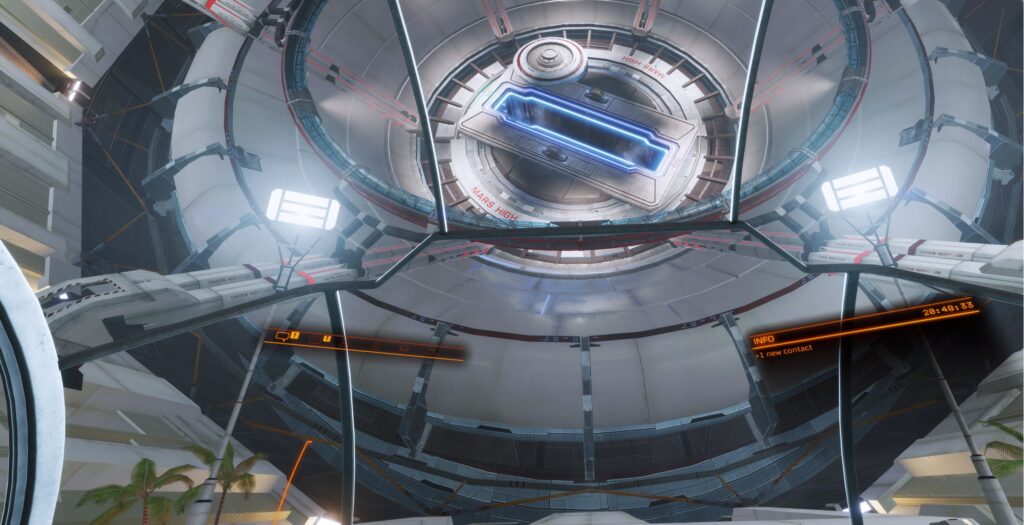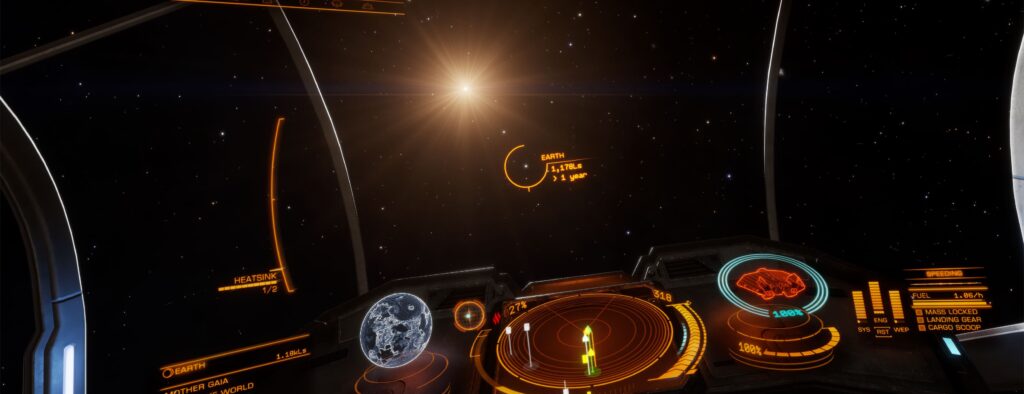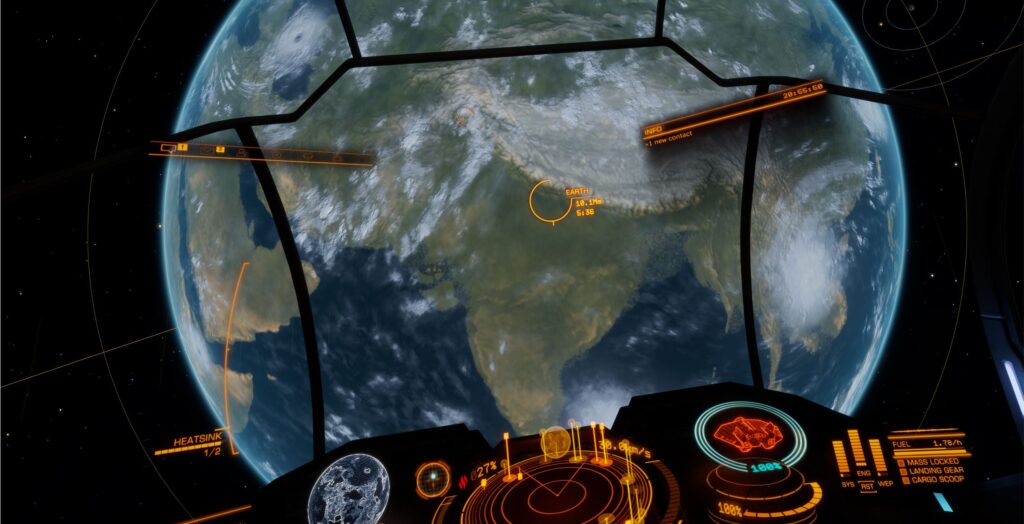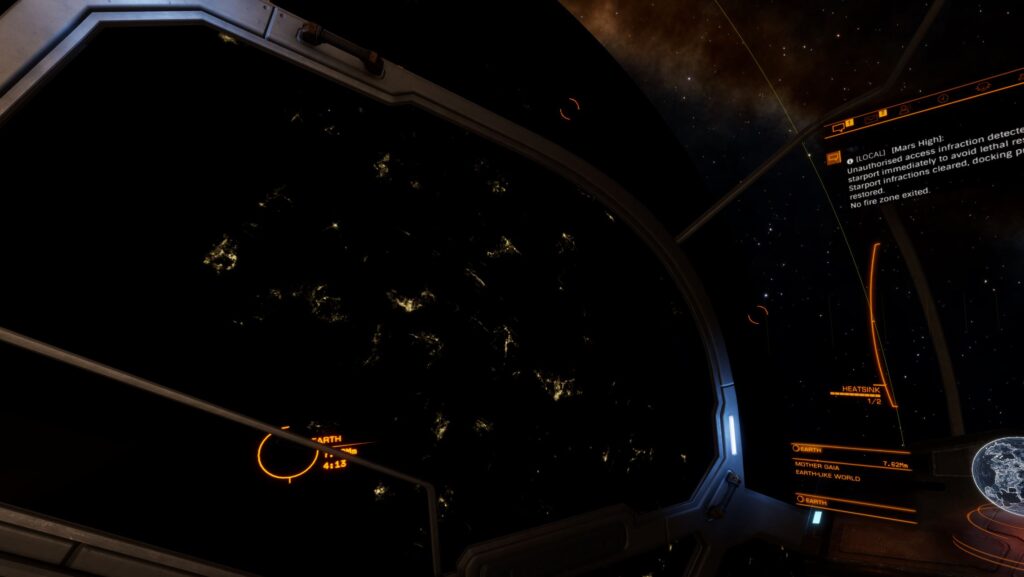
”Look again at that dot. That’s here. That’s home. That’s us. On it everyone you love, everyone you know, everyone you ever heard of, every human being who ever was, lived out their lives. The aggregate of our joy and suffering, thousands of confident religions, ideologies, and economic doctrines, every hunter and forager, every hero and coward, every creator and destroyer of civilization, every king and peasant, every young couple in love, every mother and father, hopeful child, inventor and explorer, every teacher of morals, every corrupt politician, every “superstar,” every “supreme leader,” every saint and sinner in the history of our species lived there–on a mote of dust suspended in a sunbeam.” — Carl Sagan, Pale Blue Dot, 1994
So, dear CMDRs, you have done the legwork. You have been saving for that Asp Explorer, especially since they showed it to you in full 3D down at the station. You relocated to the Sothis-Ceos system, worked your butt off, and finally got your Sol permit. Yes, I know it was grindy drudgery, but it’s done. What’s next for you CMDR? Why, it’s taking a break from your passenger ferrying business to the tourist trap called Sirius Atmospherics and making that trip to the mother planet, the home of humanity, the place where it all began. I speak, of course, is that pilgrimage to see Earth, that almost mythical place from where humanity arose, that you have heard of in your childhood tales and that you have been preparing for so long.
Whoa, whoa, let’s back up. What is going on here? Who’s CMDR? What’s an Asp (isn’t that a snake)? What are Sothis, Ceos, and all that stuff mentioned above? What is a Sol permit and why do we need to “visit” Earth? We are already here!
Dear Reader(s), these are all terms from Elite Dangerous, the fantastic space flight simulation game from Frontier Developments, where players (aka Commander or CMDR for short) pilot their spaceship(s) in a realistic 1:1 scale open-world representation of the Milky Way galaxy. Elite Dangerous mirrors our own history till a point and then diverges to a future where space flight between star systems is as common as driving to the next town. The game itself is open-ended with no clear end but a lot of opportunities to pursue multiple career paths, buy different ships, make money (or credits) and get into space fights. A peculiar detail about the game is that our own Solar system, with the sun Sol and our very own Earth is locked out at the beginning of the game. Players need to align themselves with this faction that controls the Sol System and do some chores to earn a permit that unlocks the system. for most players, it is a labor of love to earn that permit and a pilgrimage to make it back to the place where it all began and see the beautiful pale blue dot.
Ok, back to you, CMDRs. Still planning that trip? Here is what I would ask you to consider. Do yourself a favor and get yourself a VR Headset. Elite Dangerous (or ED as we like to call it) has been built ground up for VR (although VR support for the latest Odyssey expansion is very, very iffy, to say the least). Many gamers bought their first VR headsets for the experience of playing ED on VR. Many who already had a VR headset quickly added ED to their game library. After trying it out myself, I can see why.
I recently bought the Oculus Quest 2 headset. I also picked up a gaming PC locally, fitted it out with an NVIDIA 1060 6 TB GPU, and decided to take ED out for a spin. After connecting it with the Oculus Link cable
My journey started from the Robigo system, my usual hangout location ( I earn my in-game credits by running a passenger service to a tourist beacon called Sirius Atmospherics, from Robigo Mines). From there it is 13 or so jumps to the Mars High Station, where I wanted a quick layover. A jump in ED is a hop between one star to another star and is measured in light-years. The distance that one can in a jump depends on the ship, as different ships in ED have different jump ranges, which can be enhanced using more powerful or lighter modules. I prefer to travel and explore using my Asp Explorer, a hardy ship built for long-range exploration. My ship, as it is fitted currently allows me to jump around 34 light-years at a time, which makes it around 442 light-years from my origin to the Sol system.
CMDRs, you know the routine. You push the ship into hyperdrive, get pulled through hyperspace, and appear right in front of the start system you are aiming for in that jump. Only in VR, the experience in\s different. Unlike a flat-screen, you can look around you as you are pulled through hyperspace, and the wonderful colors feel almost real, till the destination start pops up right in front of you. Make sure that you are seated for the ride, CMDRs, else it can be a bit disorienting.
Mars High, as the name might suggest, is a space station orbiting Mars, which has been colonized in the game lore. Stations are humongous structures in ED and the main places for players to spend time in, do business and generally hang out while they are not flying around. From Mars High, it was a quick jump to visit earth and back to this or another station (since you cannot land on Earth yet).

As soon as one departs the station through the “mail slot” (the main entrance to the station, outlined above in blue) the “pale blue dot” shows up, with its distance from the station in light-seconds and the time it would take to reach at the current speed.

Of course, the actual distance from Mars to Earth is in light minutes (remember, the galaxy is simulated in real distances for this game), so the spaceship needs to get into supercruise (ED speak for warp-speeds within a system). I always use Supercruise Assist, a module that allows me to lock the destination in supercruise, point the ship in the right direction and relax. Once we reach the destination, Supercruise Assist pulls the ship out of supercruise and into real space. Many veteran players hate Supercruise Assist, but I find it relaxing, as I can do something else, like maybe catch up on Star Trek on a different screen. Imagine being in an Uber cruising down a scenic highway. Only instead of an Uber, it is an interstellar capable spaceship charting you between planets, and instead of a scenic highway, its is the entire universe looking back at you. The Asp Explorer, built for exploration, is simply the best in experiencing these moments in VR, as the protruding glass cockpit allows you to look up, down, sideways, and see the stars all around.
As the distance ticks down, I can see the pale blue dot become a big blue and green ball, and I see the Earth in all its glory.

It is actually amazing that as I approach, I see that I am right where India is, which is where I am from. It was truly as if I had returned home. The picture does not do the feeling justice, nor does simply seeing it in 2D. I have seen this many times before and as impressed as I had been earlier, seeing it in 3D is at a completely different level.
When “Captain Kirk” William Shatner went to space in October 2021, he said, “I hope I never recover from this”. He went on to expand upon his sense of vulnerability about the Earth’s thin atmosphere protecting all of us and declared that “Everybody in the world needs to see this.” I am only playing a computer game, and not actually going out to space, but ED in VR allows me to experience at least some of the magic as I orbit the Earth.

I decide to go once around the Earth before I head back to the station. My goal is to see the transition from the light side to the dark side and back, especially to look at sunrise from space.

As I pass over the dark side I can see the splotches of light that represent human habitats or cities. Note the positioning of this picture; it is to the left of the cockpit, which means I looked to the left and the VR headset showed me what it would look like as if I was in a real cockpit. This is the same sense of being present in the moment, in a (virtual) real environment.
As I traverse the globe, I get to see the sunrise, and it does not disappoint.

Now let’s compare this with a picture taken by NASA from the ISS.

Source: https://www.nasa.gov/multimedia/imagegallery/image_feature_2505.html
Keep in mind that while the NASA picture is in (beautiful) 2D, I am seeing it all in glorious 3D, with the expanse of the Milky Way beside me. It may not rival an actual journey to space, but it is an amazing experience nevertheless.
Once I am done orbiting the Earth, there is nothing much to do, as Frontier has not allowed landing on the planet yet. So I make my way to the nearest space station for refueling and onward plans. I head towards Abraham Lincoln, an in-game space station that is around 12 light-seconds from the Earth. I lock the destination and engage Supercruise Assist.
I emerge from supercruise right in from of the station, which saves me time in actually navigating to the mail slot.

I ask for docking permission and glide my ship to the allotted docking bay, fill up the tanks, and am ready to disembark.

CMDRs, is getting a VR set worth it? If you can afford it (and the GPU recommendations make it a big IF), then absolutely go for it. You will not regret it. Non-playing readers who already have a VR set, I would highly recommend you try it out. The closest experience to ED on the Oculus Quest is “End Space” but so far it seems more focused on fighting bogies and nothing much else.
All in all, visiting Sol and Earth was a fantastic experience and I wish everyone will get a chance to see in real life what I saw on VR.
Till then, CMDRs, fly safe and see you in the black. O7 CMDRs.